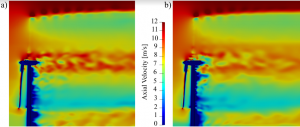New publication by wind energy team members of our group, Marielle de Oliveira, Rodolfo Curci Puraca and Bruno Carmo.
Blade-resolved numerical simulations of the NREL offshore 5 MW baseline wind turbine in full scale: A study of proper solver configuration and discretization strategies
This paper presents a blade-resolved numerical investigation of the NREL 5 MW baseline wind turbine for offshore applications including blade-tower interference, analyzing the solver configuration and its influence on the results accuracy and computational costs. The computational analyses were carried out using a Computational Fluid Dynamics (CFD) methodology employing the Finite Volume Method (FVM) implemented in the OpenFOAM software considering different approaches of the Pressure Implicit Split Operator (PISO) solver and different mesh refinement strategies for the spatial discretization process, which resulted in two different meshes being investigated. For one of the meshes, a temporal discretization analysis was performed for three different CFL numbers. The iterative form of the PISO algorithm was considered in its generic form and with an extra step to correct the pressure before the beginning of the iterative process in each time step. Both approaches can be accomplished in OpenFOAM through the PIMPLE solver facilities for the treatment of the pressure-velocity coupling in unsteady problems. The analysis of the transient incompressible turbulent flow was conducted considering the same turbulence model for all CFD investigations, the URANS k − ω SST. A numerical verification was conducted in each analysis by comparing the CFD results against values obtained using the blade element momentum theory, implemented in OpenFAST. To conclude each analysis, a computational cost investigation was carried out. Finally, for the spatial and temporal discretization investigation, detailed information regarding the flow characteristics is presented. According to the accuracy of the results obtained through the CFD simulations, the best numerical arrangement is given by the iterative PISO with face flux correction as pressure-based solver and a temporal discretization which employs lower values of CFL, such as 1 or 2.
Link: https://lnkd.in/eiSXGS6D

